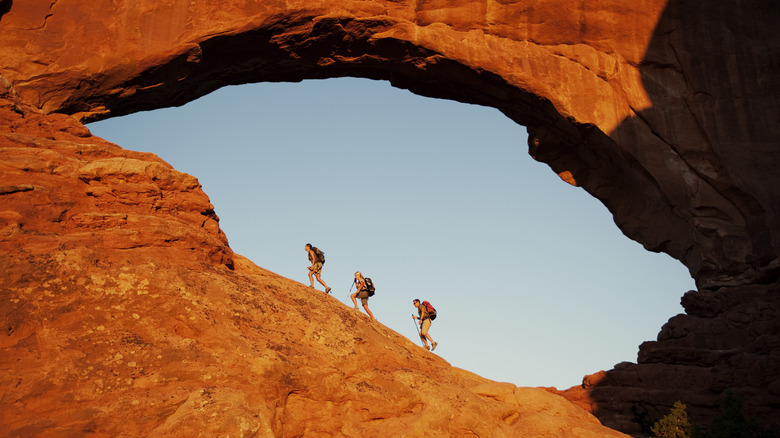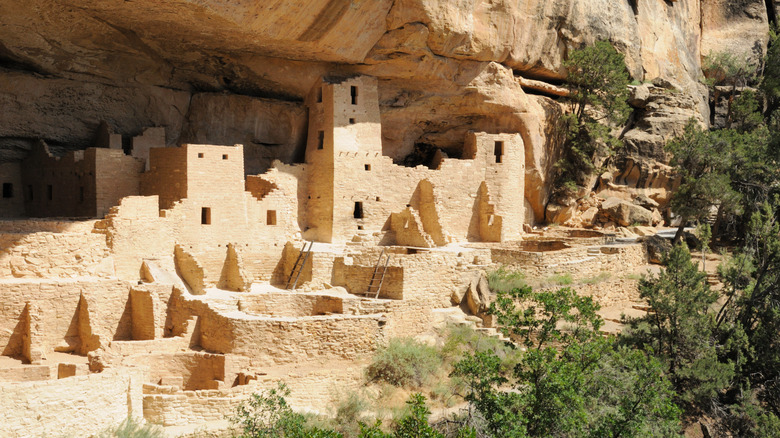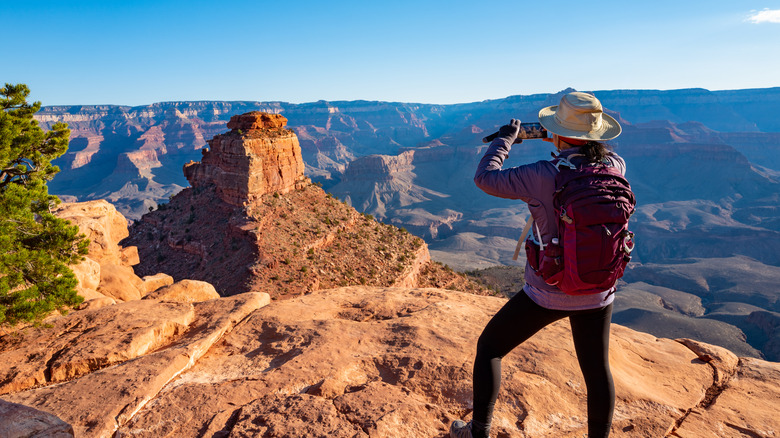See 9 Different National Parks On This Incredible Western US Road Trip
The American Southwest is known for its incredible national parks and stunning views. For travelers looking to explore this part of the country, there's no better way than taking a road trip through the Grand Circle. Depending on your location and starting point, this route travels through nine different national parks in five states — Utah, Arizona, Colorado, New Mexico, and Nevada. Though there are shorter versions and iterations of the trip that skip over some of the parks, visiting all nine parks in order gives you an efficient itinerary and ample time to explore each park.
With parks in Utah, Colorado, and Arizona, the trip will take at least 15 days, but additional time at each park will allow you to explore even deeper. A well over 1,500-mile journey, the Grand Circle adventure typically begins in Las Vegas. Vegas is a popular starting point because of its large airport, rental car options, and its close distance to Arizona and Western Utah.
Though you can take the Grand Circle in reverse order, heading east to Zion National Park is a closer option and an easier start to the trip. Zion is just a short, two-hour drive east of Las Vegas. Home to the famous Angel's Landing hike, Zion offers steep, distinctly red, towering cliffs and deep, carved canyons to explore. Because each park requires an entrance fee, stop at the entrance to Zion to purchase the $80 America the Beautiful Interagency Annual Pass, which is good for all national parks.
Utah's remaining Mighty 5 in four days
After a day or two in Zion, head another two hours northeast to the otherworldly landscape of Bryce Canyon. Set aside at least one to two full days to hike along the Bryce Canyon Rim Trail, camp overnight, or venture down into the canyons for an up-close look at the iconic hoodoos— natural rock formations shaped by erosion over thousands of years.
Next, head another two hours east to Capitol Reef, known for its rugged terrain and historic fruit orchards. Take the scenic drive through the Waterpocket Fold, or take the day to hike through one of the many slot canyons or camp under the stars. Capitol Reef's petroglyphs along State Route 24 and Fremont culture artifacts at the visitor center are a must-see for history buffs.
Moab, Utah, is home to the next two national parks on the Grand Circle road trip: Canyonlands and Arches National Park. Arches is home to over 2,000 sandstone arches, like the iconic Delicate Arch, set against a stunning desert backdrop. Arches National Park is also one of the best rock-climbing destinations in the country. A mere 26 miles from Arches, Canyonlands offers a landscape shaped by the mighty Colorado River. The park is divided into four districts, giving visitors access to views of nearby mesas at the Island in the Sky, massive red rock spires in the Needles district, and more.
Cliff dwellings and canyons in Colorado
A three-hour drive from Moab's two National Parks, Black Canyon of the Gunnison is a dramatic canyon featuring the state's highest cliffs and plunging depths. Carved over millions of years by the relentless Gunnison River, the Black Canyon's steep walls plunge to depths of over 2,000 feet, creating dark, black canyon walls. Take the day to explore the park's Painted Wall, the Narrows, and many overlooks, or grab a wilderness use pass to hike down into the canyon.
Due to the distance between Colorado's two parks on the Grand Circle road trip, it is best to divide these two among at least two days each. Continuing three hours south to Cortez, Colorado, explore the archaeological wonders of Mesa Verde National Park, like the ancient Puebloan cliff dwellings.The park is a UNESCO World Heritage Site that details the lives of ancient Puebloans who thrived in the area for centuries.
Visitors can explore remarkably intricate stone structures tucked into the cliffsides, like the iconic Cliff Palace. Beyond the archaeological wonders, Mesa Verde provides multiple campgrounds, and the surrounding area has plenty of lodging options before heading on to the next leg of the Grand Circle. Touring the park's cliff dwellings will provide a deeper understanding of how these ancient people lived, their innovative building techniques, and their relationship with the land.
Arizona's Grand Canyon and Petrified Forest
Arizona's Petrified Forest National Park is just a three-hour trip south of Mesa Verde. Visitors can hike through the otherworldly landscape of ancient petrified trees, some dating back over 200 million years. The park also boasts colorful badlands, backcountry hiking opportunities, and the Puerco Pueblo ruins. Petrified Forest National Park is also a designated International Dark Sky Park, offering stargazing opportunities in the clear Arizona night skies.
Because of the three-hour distance between Arizona's two parks on the Grand Circle road trip, taking at least one to two days at each park is recommended. The Grand Canyon is the Grand Circle's ninth and final National Park and one of the World's Seven Natural Wonders. The canyon measures a mile deep and up to 18 miles wide, the largest canyon in the United States.
Visitors can explore the canyon's vastness by foot on the Bright Angel Trail with a backcountry permit. The Grand Canyon's South Rim is also home to the historic Grand Canyon Village, where visitors can learn about the area's geological and cultural history at the visitor center or stroll along one of the many scenic trails. Whether you end your adventure at the Grand Canyon or opt for a reverse order of the Grand Circle road trip, the Grand Canyon is integral to American history and a must-see destination on any Southwest road trip.



